Author(s): Abiola Clementina Ajibola*, Emmanuel Fatunsin, Ibidun Jolaoso, Victor Obangulu, Olakunle Yusuf, Ray Desmond Umechinedu Francis Ogirima, Collins Imarhiagbe, Pius Christopher-Izere, Emmanuel Udeh, Saude Sagir, Nafisa Isa, IIiyasu Neyu and Bolanle Oyeledun
COVID-19 pandemic caused by Severe Acute Respiratory Syndrome Coronavirus 2 (SARS-COV-2) was first discovered in December 2019 in Wuhan, China and later declared a pandemic on March 11, 2020 by the WHO. This study was conducted to assess the impact of COVID -19 pandemic and its attendant infection prevention of lockdown on ANC utilization and deliveries by skilled birth attendants in Kaduna State. It is a retrospective data review of 18 months data on ANC clinic visit and skill birth delivery from 1,722 health facilities. October 2019 to March 2021 data was extracted from the DHIS 2. The analysis was carried on SPSS using One Way ANOVA. A decline of 13.5% antenatal attendance for first booking compared to pre-COVID-19 was recorded. There was a slight increase of 3.5% Post-COVID-19. There was also a reduction of 4.1% in the number of pregnant women who had the four recommended ANC visits during the COVID-19 compared to pre-COVID-19 period. However, Pregnant women returning after COVID-19 had a reduction of 10.2% compared to during COVID-19. The study revealed increased number of pregnant women that delivered during and post COVID-19. There was an increase of 2, 753 and 1,699 during and post-COVID-19, respectively. At 95% confidence interval using significance value is 0.610 (i.e., p = .610), the significance is more than 0.05. Therefore, there is no statistically significant difference in the ANC utilization and skill birth attendance before, during and after the Covid-19 pandemic. Therefore Covid-19 did not affect ANC and skill birth deliveries.
On December 31, 2020, WHO approved the Pfizer vaccine for emergency use and as of 12th May 2021, 1.2 billion people have been vaccinated globally.1 According to WHO, Nigeria currently has a total of 165,612 confirmed cases with 2,066 reported mortality. Vaccination coverage in Nigeria is on the rise with about 1.4 million people vaccinated with AstraZeneca Covid vaccine.1 Nigeria reported an average of 5,261 cases in the second week of December 2020 as compared to the latest data of 41 reported cases on 15th May 2021[2].
In Nigeria, COVID-19 pandemic has affected various sectors of the economy negatively because of Government enforced lockdowns as well as fears from associated morbidity and mortality from the infection. The Nigerian health sector has been plagued with inadequacies including shortages of human resources, lack of equipment, infrastructural decays leading to distrust by the public. Due to COVID the health sector is also stretched thin with a ratio of 1 doctor to about 22,000 Nigerians in rural areas as opposed to the 1:600 recommended by the WHO [3].According to Tanvir Ahmed, 2021, there was reduction in utilization of basic essential MNCH services such as antenatal care, family planning and immunization in Bangladesh, Nigeria and South Africa due to lockdown, fear of contracting the COVID-19 and resource constraints, deterred people from accessing basic MNCH care [4].
ANC visits in Nigeria has been perennially low, a study suggested that only 53.5% mothers had four antenatal visits in Nigeria[5]. This shows the gross underuse of ANC facilities in Nigeria. Delivery rate according to NDHS 2018 revealed that only 43% of all births in Nigeria were attended to by a skilled provider [6].Kaduna State, located in the Northern part of the country has available National data that revealed 9068 cases of COVID-19 from 2020 to date with 65 deaths[2]. Kaduna state government like other governments around the world introduced some drastic measures to curb COVID-19 spread including partial or total lockdown as deemed necessary based on prevailing circumstances.
Kaduna State has 608 Local Government health facilities, 656 private health facilities, 23 secondary hospitals and two tertiary hospitals aside specialized health facilities. Health Care Services in the State is plagued by shortage of human resource for health in medicine, pharmacy, laboratory science, x-ray, etc. Available statistics shows, there are 133 doctors in the public service and 56 in the private practice. The State Health Sector goal is to ensure all citizens of Kaduna state have quick and easy access to improved and affordable curative, preventive, rehabilitative and promotive health services. The State Healthcare policy focuses on key deliverables including: Free healthcare for pregnant women and children under 5 (40% of population); malaria treatment and prevention for all. The State has unacceptably poor health indices and heavy disease burden; Infant mortality rate - 103/1000, Maternal mortality rate - 800/100,000, under five mortality rate - 170/1000, TB prevalence rate - 4/1,000, and Fertility rate - 6.1[7].According to WHO in July 2020, Kaduna State witnessed over 50% reduction in hospital attendance and access to services due to disruption of routine essential services and programmes resulting from prioritization of COVID-19 response[8]. This is suggestive that utilization of antenatal care services might also be affected.
Studies established that utilization of Antenatal care (ANC) services will reduce neonatal deaths. In 2016 WHO introduced the New ANC Model for Positive Experience because the focus Ante natal Care (FANC) was not promoting positive pregnancy experience and desired perinatal death reduction. This was reduced to six physical contact and two virtual contacts during COVID-19 pandemic[9]. Kaduna state commenced eight contact visits in 255 Primary health care facilities in January 2021, though other facilities are on the four focussed visits. ANC 1 which is also known as Booking, is the first Antenatal visit to the health facility, and WHO recommends that this should take place before 16 weeks of gestation[10]. ANC 4 is the 4th recommended antenatal visit by WHO at 36 weeks of gestation[10]. The 4th ANC visit is a priority indicator in the State. Study on the impact of COVID-19 on pregnant women, revealed 69.3% had missed at least one antenatal care service and 24.2% had experienced traveling difficulties to seek health care during the lockdown. Inadequate antenatal care during the lockdown was reported as 24.2%.11 We aim to carry out this study to assess the decline and return rate of pregnant women in utilizing ANC services and delivery by skilled birth service providers due to COVID-19 pandemic. The findings of this study will assist Kaduna state government in developing strategies for the utilization of ANC and in designing strategies for other MNCH services.
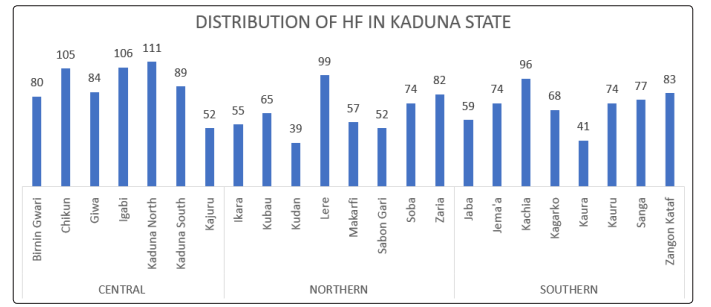
Figure 1: A bar chart showing the distribution of the Health facilities across Kaduna stae, highlighting the distribution across LGAs and Senatorial Zones
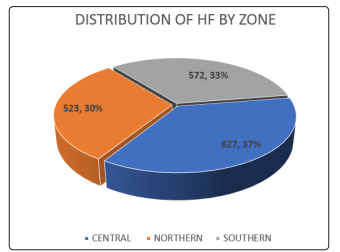
Figure 2: A Pie Chart showing the distribution and proportion of health facilities across the 3 senatorial zones in Kaduna
The data review revealed that ANC 1 reduced sharply from 233,417 recorded in the pre-COVID-19 Period to 201,946 in the COVID-19 period, and rose significantly to 209, 055 during the post-COVID-19 period. The Northern and Southern senatorial zones also experienced similar trend in ANC 1 as there was 113, 927 and 46,655 ANC 1 in the Pre-COVID-19 period; 106,070 and 33,261 in the COVID-19 period, and 110,991 and 36,276 in the post-COVID-19 period, respectively. The Central senatorial zone took a different trend from the others as it recorded 72,835 ANC 1 in the Pre-COVID-19 period, 62,660 in the COVID-19 period, and a slight increment of just 872 in the Post-COVID-19 period with ANC 1 of 61,788. Most of the 23 LGAs also shows a dip in ANC 1 from the Pre-COVID-19 period to the COVID-19 period, except for Igabi and Kagarko LGA which recorded a pre- COVID-19 ANC 1 of 12,247 and 4,515, respectively, lower than COVID-19 period of 13,496 and 4,600, respectively. At 95% confidence interval using significance value is 0.648 (i.e., p = 0.648), the significance is more than 0.05. Therefore, there is no statistically significant difference in the ANC 1 Attendance pre-, during and post-COVID-19 pandemic. Therefore, COVID-19 did not influence ANC 1 Attendance.
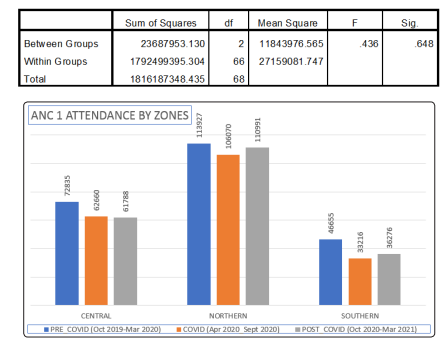
Figure 3: A Bar Chart showing Number of ANC 1 across the senatorial zones in the 3 periods analyzed
ANC 4 is the 4th recommended antenatal visit by WHO at 36 weeks of gestation[10]. Data review showed that the pre-COVID-19 Period had a visit of 113,917, while visit at the COVID-19 period was the highest with 118,671 and a post-COVID-19 period visit of 107,822. The Northern senatorial zone almost exhibited the same ANC 4 visit trend as it recorded 59,227 in the Pre-COVID-19 period and 71,237 in the COVID-19 period, with a slightly higher visit in the Post-COVID-19 period of 59,896 than in the Pre- COVID-19 period. The Southern and Central senatorial zone shows a higher ANC 4 visit in the Pre-COVID-19 period, with a slight dip in both the COVID-19 and Post-COVID-19 period and a little difference between the later. The Central zone had 39,300 pre-COVID-19 ANC 4 visit, 33,074 COVID-19, and 33,008 post- COVID-19 ANC 4 visit, while the southern zone had 15,390 (pre- COVID-19), 14,360 (COVID-19), and 14,918 (Post-COVID-19). The Northern Zone just as it is in ANC 1 visit notably recorded more ANC 4 visit than the other two zones, with the southern zone having the lowest number of ANC 4 visit.Kachia, Igabi, Kaura, and Kauru LGAs all had a lower pre- COVID-19 ANC 4 visits, compared with other LGAs with a higher Pre-COVID-19 period ANC visit. Sabon Gari LGA had a significantly higher COVID-19 period ANC 4 visits (13,537) compared to both the Pre- and Post-COVID-19 era, 6,860 and 7,783, respectively. At 95% confidence interval using significance value is 0.916 (i.e., p = 0.916), the significance is more than 0.05. Therefore, there is no statistically significant difference in the ANC 4 Attendance before, during and after the Covid-19 pandemic. Therefore, Covid-19 did not impact on ANC 4 Attendance.
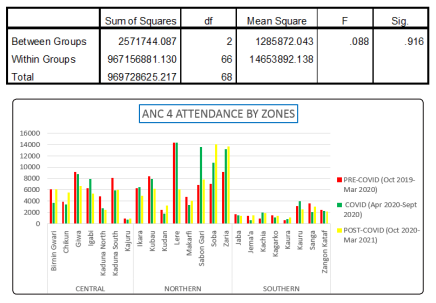
Figure 4: A chart showing the ANC 4 visit across the 23 LGAs and the 3 senatorial zones of Kaduna
ANC Total Attendance review showed that there were 559,114 visits in the Pre-COVID -19 period, 479,483 in the COVID-19 period and 545,83 in the Post-COVID-19 period. The Central, Northern, and Southern senatorial zones had ANC total attendance in the Pre-COVID-19 period of (196,444, 266,704, and 95,9660, respectively), a COVID-19 period of (160,064, 245,384, and 74,035, respectively), and a Post-COVID-19 period of (169,041, 288,998, and 87,414, respectively). Again, the Northern zone generally had a higher ANC total attendance than the other zones, with the southern zone registering the lowest. All the LGAs recorded a higher Pre-COVID-19 ANC total attendance, except at Kagarko LGA where the COVID-19 ANC total attendance was a bit higher than the Pre-COVID-19 period. The Post-COVID-19 ANC Total attendance was notably higher in these LGAs Igabi, Jema’a, Kagarko, Kubau, Kudan,Makarfi, Sabon Gari, Soba, and Zaria. At 95% confidence interval using significance value is 0.610 (i.e., p = .610), the significance is more than 0.05. Therefore, there is no statistically significant difference in the ANC Total Attendance before, during and after the Covid-19 pandemic. Therefore Covid-19 did not affect ANC Total Attendance.Table 3: Showing ANOVA observation for ANC Total Attendance
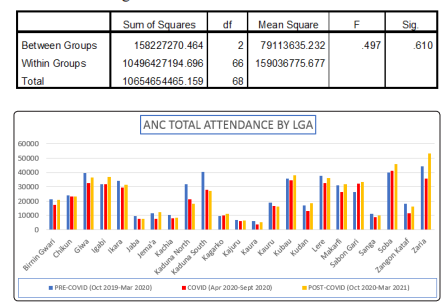
Figure 5: A chart showing the ANC total attendance in the 23 LGAs of Kaduna in the Pre- COVID-19, COVID-19, and Post- COVID-19 period
Skilled Birth Attendant (SBA) as defined in a joint statement by WHO, International Confederation of Midwives (ICM), and Federation of Obstetricians and Gynecologist (FIGO) as ?an accredited health professional such as a midwife, doctor or nurse who has been educated and trained to proficiency in the skills needed to manage normal (uncomplicated) pregnancies, childbirth and the immediate postnatal period, and in identification, management and referral of complications in women and newborns?[12]. From the data review, it revealed an increasingly number of deliveries by SBAs from the Pre-, COVID-19 to the Post-COVID-19 period of 66,464, 69,217, and 70,916, respectively. The Northern senatorial zone shows a similar trend of increasingly number of deliveries by SBA across the three periods (Pre-COVID-19 24,829, COVID-19 29,662, and 31,406 for the Post-COVID-19 period). The Central zone exhibited an opposite trend as it shows a decline in the number of deliveries by SBA across the 3 periods of 23,193 in the Pre-COVID-19, 21,078 in the COVID-19, and 19,074 in the Post-COVID-19 period. The Southern Zone which recorded the lowest total number of deliveries by SBA, had 18,442 in the Pre- , 18,477 in the COVID-19, and 20,436 in the Post=COVID-19 period. Kabau, Kudan, Lere, Sabon Gari, Soba, Kaura and Zango Kataf LGAs had a s significantly higher deliveries by SBA in the COVID-19 period than in the Pre-COVID-19 period, in the other LGAs the reverse is the case.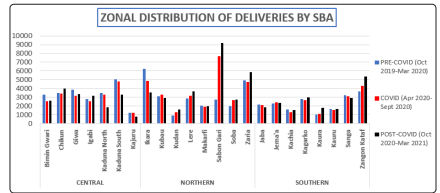
Figure 6: A Chart showing the distribution of deliveries by SBA across the 23 LGAs and Senatorial zone of Kaduna in the 3 periods reviewed
